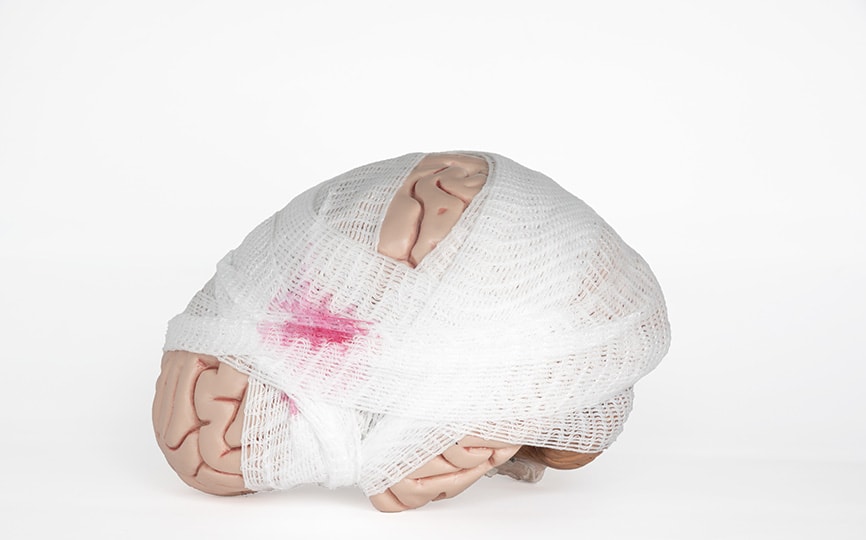Mild Traumatic Brain Injury (mTBI) in Kids and Adults
While in Melbourne this weekend Chris was invited to present to the College of Chiropractic Neuro-developmental Paediatrics (CCNP) on mild traumatic brain injury (mTBI). Read on to understand more about the dangers of concussion and how to recognise them.
Concussion is defined as any direct or indirect injury to the brain which results in a temporary loss of brain function. It is important to understand that concussion and brain injury predominantly occurs WITHOUT loss of consciousness. In fact only 15% of concussions involve a loss of consciousness. As the brain is enclosed in a fixed vault (the skull) and anchored at certain points, any impact causing excessive movement of the brain can strain these structures or cause injury through direct contact of the brain against the inside of the skull (1). While males obtain more concussions per annum, female athletes appear to suffer more detrimental effects from concussion than male athletes (2,3)
Over the last few years the dangers of concussion have become more and more apparent, with research linking concussions to Alzheimer’s disease, ALS (Lou Gehrig’s disease), Parkinson’s and dementia (2). The literature shows that for adults who sustain three or more concussions, there is an increased risk of depression, memory impairment and poor cognitive processing in the future (2).
One of the greatest dangers of concussion is “second impact syndrome” which occurs when a second concussion is sustained before the complete resolution of the first concussion (4,5). Second impact syndrome can lead to severe disability or increased symptoms with a poorer prognosis (4,5).
Cervical Injury
Head injuries rarely occur without involvement of the cervical spine. Directives from Australian Rugby Union instruct professionals to assume that there is a cervical (neck) injury until proven otherwise in cases of head trauma. Mechanisms for neck injury associated with mTBI are similar to those in whiplash (6). Assessing neck injuries associated with concussion or mTBI initially aims to exclude the possibility of fracture or other serious pathology involving the spinal column or cord. Once cleared, an assessment of soft tissue structure damage, joint biomechanics and proprioceptive function will aid in reducing long-term cervical dysfunction.
Recognise and remove
In amateur levels of sports a consensus has been reached by most governing bodies to operate a “recognise and remove” policy for those who obtain head injuries during play (7). The pocket concussion recognition tool has been designed for use field-side by non-medically trained personnel to avoid the risk of second impact syndrome. Following a suspected concussion it is important to be assessed by a trained practitioner prior to return to play. At Shirley Rd we use both the SCAT 3 and the Pondera balance systems to obtain objective data and aid in the diagnosis and management of concussion.
Return to play guidelines
Under 15s who sustain a concussion are directed to have 2 weeks rest followed by a graduated return to play programme (GRTP), whereby they are incrementally increased from light training back into contact sports ensuring there is no worsening of symptoms of concussion. The earliest return to play in this age-category is 23 days post concussion.
Under 18s who sustain a concussion are directed to have 1 weeks rest, followed by the GRTP. As with the under 15’s, it is important to ensure there are no symptoms of concussion during each stage of the GRTP. The earliest return to play for these players is 12 days.
Over 19s are required to rest for 24 hours before entering the GRTP. If they remain symptom free, they are able to return to full competition in 6 days.
With the growing body of evidence pointing towards the long-term harm of concussions and the importance of diagnosis and removal from play, we at Shirley Rd Chiropractic are striving to remain ahead of the curve with regards to both short and long term management of mTBI and concussion. Secondary to previous research undertaken, Chris and Brent attended the 2014 Australasian Academy of Functional Neurology’s annual conference, in Melbourne, entitled Concussion, Mild Traumatic Brain Injury and Mood Disorders.
If you have any questions or queries regarding cervical spine injury, concussion or mTBI, or would like to arrange a presentation for your work-place or sports club, please contact us.
References
1) McCrory P, Meeuwisse W, Johnston K, Dvorak J, Aubry M, Molloy M, et al. Consensus statement on concussion in sport: The 3rd International Conference on Concussion in Sport held in Zurich, November 2008. British Journal of Sports Medicine. 2009;43(SUPPL. 1):i76-i84.
2) Langlois JA, Rutland-Brown W, Wald MM. The epidemiology and impact of traumatic brain injury: a brief overview. J Head Trauma Rehabil. 2006 Sep-Oct;21(5):375-8.
3) Covassin T, Elbin RJ, Harris W, Parker T, Kontos A. The role of age and sex in symptoms, neurocognitive performance, and postural stability in athletes after concussion. Am J Sports Med. 2012 Jun;40(6):1303-12.
4) Cantu RC. Second Impact Syndrome. Clinics in Sports Medicine. 1998;17(1):37-44.
5) Marar M, McIlvain NM, Fields SK, Comstock RD. Epidemiology of concussions among United States high school athletes in 20 sports. Am J Sports Med. 2012 Apr;40(4):747-55.
6) Hynes L M, Dickey J P. Is there a relationship between Whiplash-associated disorders and concussion in hockey? A preliminary study. Brain Injury. 2006 Feb;20(2):179-88
7) http://www.rugby.com.au/tryrugby/Administration/ConcussionGuidelines.aspx
8) Echlin et al. Return to play after an initial or recurrent concussion in a prospective study of physician-observed junior ice hockey concussions: implications for return to play after a concussion. Neurosurg Focus 29 (5):E5, 2010; 1-5.
9) http://theconcussionblog.com/2011/11/08/rugby-makes-clear-statements/


Leave A Comment
You must be logged in to post a comment.